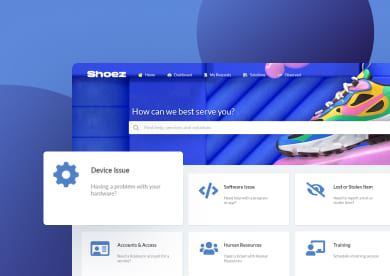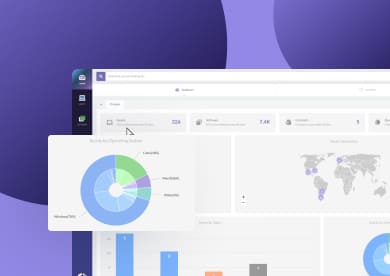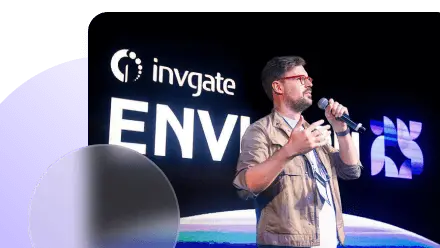Hardware inventory software is essential for keeping IT operations organized, cost-effective, and secure. It allows IT teams to automate Hardware Inventory Management (HIM), gain real-time visibility over devices, and ensure every asset is accounted for across its lifecycle.
There are plenty of Hardware Inventory Management software options on the market (from open-source tools to enterprise-grade platforms), each offering different features, pricing models, and levels of complexity.
In this guide, we’ll walk you through what hardware inventory software does, compare the top 9 tools for 2026, and help you find the right fit for your organization’s needs.

What is Hardware Inventory Management?
Hardware Inventory Management is the practice of tracking, organizing, and maintaining physical hardware assets within an organization. It is a core function of Hardware Asset Management (HAM) and, by extension, IT Asset Management.
In practice, this discipline is most commonly applied to IT hardware, such as laptops, servers, network devices, and peripherals, although the term is sometimes used more broadly to describe non-IT physical assets as well.
The goal is to ensure hardware is accurately recorded, properly used, and maintained or replaced at the right time, helping organizations reduce waste, control costs, and improve accountability.
What is IT Hardware Inventory Management?
IT Hardware Inventory Management is often used interchangeably with Hardware Inventory Management, as both terms typically refer to the tracking and control of IT hardware.
When a distinction is made, IT Hardware Inventory Management explicitly focuses on technology assets managed by IT teams, such as laptops, servers, network devices, and peripherals.
Its purpose is to give IT teams accurate visibility into where these assets are, how they’re being used, and what condition they’re in, supporting day-to-day operations, planning, and decision-making.
For the sake of simplicity, throughout this article we’ll use Hardware Inventory Management and IT Hardware Inventory Management interchangeably.
Hardware inventory vs asset tracking: What’s the difference?
Hardware inventory and asset tracking are related, but they are not the same. The key difference is scope: hardware inventory focuses on identifying and listing physical equipment, while asset tracking follows those assets across their entire lifecycle, adding operational and financial context.
Hardware inventory is about knowing what hardware exists in an organization. It records asset details such as type, model, serial number, and current status, offering a clear snapshot of physical assets at a specific point in time.
Asset tracking goes further by monitoring how assets are used and managed over time. It includes inventory data, but also covers assignment, location changes, usage history, depreciation, and lifecycle stages, enabling better control, planning, and accountability.
What is IT hardware inventory software?
IT hardware inventory software is a digital tool that helps organizations keep track of their physical IT devices in one centralized place.
Instead of relying on spreadsheets or manual updates, it automates the process and provides visibility into what technology assets you own, where they are, who uses them, and their current status.
Peripherals inventory: What to track beyond computers
Laptops and desktops are some of the most common IT assets in any organization, but they are far from the only ones that need to be tracked. A complete hardware inventory should also include the peripherals and supporting equipment that enable daily operations and often represent hidden costs or security risks when overlooked.
With the right hardware inventory software, organizations can track a wide range of IT assets, including:
- Printers and multifunction devices.
- Monitors and docking stations.
- Keyboards, mice, and headsets.
- Network equipment such as routers, switches, and access points.
- External storage devices and peripherals.
- Mobile devices and accessories.
- Specialized or shared equipment used across teams.
Tracking these assets helps improve visibility, accountability, and lifecycle planning across the entire IT environment, not just end-user computers.
How do you track USB-connected printers and other peripherals?
USB-connected peripherals, especially printers, are often missed by traditional inventory processes because they are attached to individual computers rather than the network. Modern hardware inventory software can close this gap by automatically detecting peripherals reported by endpoint agents.
InvGate Asset Management, for example, can identify USB-connected printers through its agent-based discovery and incorporate them into the inventory automatically or through manual approval. This allows IT teams to track where printers are connected, who is using them, and how they move across the organization, bringing typically overlooked devices into a centralized inventory.
What should you record for peripherals?
The level of detail you can collect depends on the type of peripheral. A printer, for instance, provides far more data than a keyboard or mouse. However, there are several core fields that apply to most peripherals and should be recorded consistently.
These typically include:
- Asset type and category.
- Manufacturer and model.
- Serial number or unique identifier.
- Assigned user or location.
- Connection type (USB, network, shared).
- Current status (in use, in storage, retired).
- Lifecycle stage and dates.
Capturing this information ensures that peripherals are not treated as disposable or invisible assets, but as part of a controlled, auditable hardware inventory.
Methodology: How we reviewed hardware inventory software
InvGate develops and markets IT Asset Management software, which means we are an active participant in this category. While some of the tools mentioned in this article may be considered alternatives, our goal is to provide accurate, neutral, and useful information to help readers evaluate hardware inventory software options.
Sources, access dates, and inclusion criteria
Our analysis is based on publicly available information, including official vendor websites, product documentation, pricing pages (when disclosed), and user reviews from platforms such as Gartner Peer Insights, G2, and Capterra. Tools were included based on relevance to hardware inventory use cases, feature availability, and market visibility.
Information is accurate as of December 2025 and may change as vendors update their products.
Disclosure, trademarks, and required disclaimers
This article is published by InvGate for informational purposes only. All comparisons reflect the author’s independent evaluation and are based on publicly available data.
All product names, logos, and brands are property of their respective owners. Use of these names, trademarks, and brands does not imply endorsement or partnership. Comparisons are provided for informational purposes and may be subject to change without notice.
Hardware inventory software options and selection checklist
There are many hardware inventory software options on the market, but not all of them are designed specifically for IT environments. When evaluating tools for IT hardware inventory, it’s important to focus on solutions that can handle connected devices, automated discovery, lifecycle tracking, and integration with IT operations.
Some widely used IT hardware inventory software options include:
- InvGate Asset Management – A no-code IT Asset Management platform focused on automated discovery, detailed hardware tracking, lifecycle management, and tight integration with IT Service Management workflows.
- Lansweeper – Best known for its strong network-based discovery capabilities, offering broad visibility into connected IT assets across complex and distributed environments.
- ManageEngine AssetExplorer – A web-based IT Asset Management solution that supports automated discovery, lifecycle tracking, and CMDB-driven asset visibility through both cloud and on-premises deployments.
- Freshservice – A cloud-based IT Service Management platform that includes hardware inventory and asset tracking features as part of a unified ITSM and operations environment.
- Ivanti Neurons for ITAM – An enterprise-focused ITAM solution combining discovery, lifecycle management, financial tracking, and automation, with integrations across Ivanti’s broader platform.
- Snipe-IT – An open-source IT Asset Management tool commonly used for basic hardware inventory, asset assignments, and lifecycle history, especially in smaller or self-hosted environments.
- AssetTiger – A cloud-based asset tracking platform that supports hardware inventory, reporting, audits, and barcode-based tracking, with a free tier for smaller inventories.
- Flexera IT Asset Management – An enterprise-grade ITAM solution that unifies hardware, software, and SaaS management, with a strong emphasis on license optimization, normalization, and compliance.
- ServiceNow IT Asset Management – Part of the ServiceNow AI Platform, offering lifecycle automation, centralized asset visibility, and CMDB-driven Asset Management for large and complex IT environments.
Each of these tools addresses IT hardware inventory from a different angle, ranging from lightweight inventory tracking to full IT Asset Management platforms.
Hardware inventory software comparison criteria
When choosing an IT hardware inventory solution, use this checklist to evaluate whether a tool fits your organization’s needs:
- Automated discovery – Can the tool automatically detect computers, servers, network devices, and peripherals?
- Centralized inventory – Does it provide a single source of truth for all IT hardware assets?
- Lifecycle tracking – Can you track assets from acquisition to retirement, including depreciation and warranties?
- Peripheral support – Does it allow you to inventory printers, monitors, and other peripherals, including USB-connected devices?
- Scalability – Can it handle growth as your IT environment expands?
- Reporting and audits – Does it support audits, compliance reporting, and historical tracking?
- Integration with IT operations – Can it integrate with IT Service Management (ITSM), service requests, incidents, or change management processes?
- Ease of use – Is the platform intuitive enough to reduce manual effort and adoption friction?
Selecting the right hardware inventory software ultimately depends on the size of your IT environment, the level of automation you need, and how closely inventory data must integrate with your broader IT operations.
#1. InvGate Asset Management

InvGate Asset Management is an IT Asset Management platform built with usability in mind. Its no-code design and intuitive interface allow teams to adopt and use the platform effectively without requiring advanced technical expertise.
The solution is also highly adaptable. It supports both on-premise and cloud deployments and is designed to scale as organizations grow, making it suitable for small teams as well as large enterprises.
InvGate Asset Management integrates with more than 20 third-party tools, including IT Service Management platforms like InvGate Service Management, as well as solutions for remote access, identity management, and cloud services. In addition, AI-driven features and automation help teams reduce manual work and make better use of their time and resources.
InvGate Asset Management features
InvGate Asset Management provides a robust set of capabilities to support IT hardware inventory and broader IT Asset Management needs, including:
- Unified IT asset inventory - Build a complete, centralized inventory of IT hardware to identify, visualize, and manage all assets in one place. The platform also supports software and non-IT assets, enabling a single source of truth across the organization.
- Automated network discovery - Automatically detects hardware connected to the network, including laptops, desktops, USB-connected printers, smartphones, virtual machines, and more, reducing manual effort and improving inventory accuracy.
- IT hardware asset tracking - Track each hardware asset in detail, including location, ownership, status, depreciation, manufacturer, asset type, and associated service requests, providing the context needed for effective management.
- QR code asset tagging - Generate and print QR codes for physical assets to simplify on-site identification and audits. Assets can be scanned using a mobile-friendly interface to instantly access up-to-date asset information.
- Automation, reporting, and dashboards - Automate notifications and workflows with highly customizable conditions to stay ahead of issues. Create scheduled reports and visual dashboards to monitor inventory health, lifecycle status, and overall Hardware Asset Management performance.
InvGate Asset Management reviews and ratings
- Gartner Peer Insights: 4.8 out of 5 stars.
- G2: 4.7 out of 5 stars.
- Capterra: 4.4 out of 5 stars.
InvGate Asset Management has also been included as a Representative Vendor in Gartner’s Market Guide for Hardware Asset Management Tools, highlighting its strengths in Asset Lifecycle Management and ecosystem integration.
InvGate Asset Management pricing
InvGate Asset Management uses a scalable pricing model based on the number of nodes under management. A node represents any monitored device, such as a computer, server, or network switch.
- Starter Plan - Designed for smaller organizations, supports up to 500 nodes at $0.21 per node per month, billed annually at $1,250.
- Pro Plan - Intended for mid-sized environments, covers 501 to 10,000 nodes at $0.38 per node per month, billed annually.
- Enterprise Plan - Custom pricing for large organizations with advanced or specific requirements. Pricing available upon request.
Not sure which plan is right for you? You can start with a 30-day free trial, no credit card required, to explore InvGate Asset Management firsthand.
#2. Lansweeper
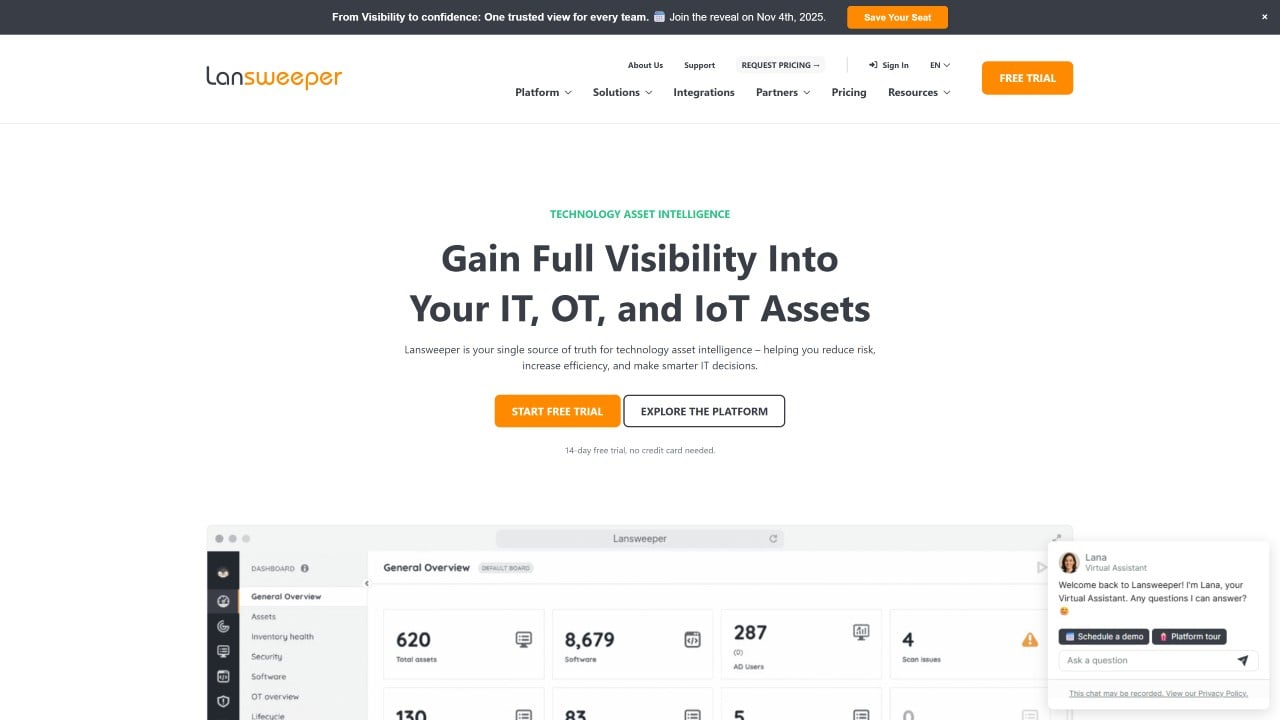
According to its official website, Lansweeper® is an IT Asset Management platform built to provide organizations with broad visibility into their IT and network environments. It helps teams discover, inventory, and manage assets across complex and distributed infrastructures, supporting both control and security initiatives.
Capterra notes that Lansweeper relies on continuous, automated asset discovery, allowing organizations to maintain accurate and up-to-date inventories without manual intervention. In addition, information shared by the Lansweeper Community confirms that the platform can be deployed on-premises or through its cloud-based option, Lansweeper Sites, giving organizations flexibility in how they implement the solution.
Lansweeper features
Based on information from Lansweeper’s official IT Asset Management documentation, the platform is designed to centralize technology asset data, automate discovery, and turn raw inventory information into actionable insight. Its core capabilities include:
- Automated asset discovery - Continuously scans and identifies IT, OT, IoT, and cloud assets across the environment, delivering near real-time visibility into all connected technology.
- End-to-end Lifecycle Management - Follows assets from acquisition through retirement, helping teams manage warranties, plan refresh cycles, and make informed upgrade decisions.
- Software Asset Management - Identifies installed applications, tracks license usage, and supports compliance efforts to reduce overspending and minimize audit exposure.
- Analytics and reporting - Provides dashboards and reports that convert asset data into meaningful insights, enabling more informed, data-driven decision-making.
- Integrations and automation - Integrates with platforms such as ServiceNow, Atlassian, HaloITSM, and Axonius, and offers APIs and workflows to support automated IT operations.
Lansweeper reviews
As of December 2025, Lansweeper shows consistent user feedback across major review platforms:
- Gartner Peer Insights: 4.2 out of 5 stars.
- G2: 4.4 out of 5 stars.
- Capterra: 4.5 out of 5 stars.
Lansweeper pricing
Lansweeper provides both free and paid licensing options to accommodate different organization sizes. The free plan supports up to 100 assets with limited functionality. A 14-day premium trial is available, granting access to advanced features before reverting to the free tier.
According to Lansweeper’s pricing information, paid subscriptions are offered in three tiers:
- Starter – Entry-level plan covering essential IT Asset Management capabilities.
- Pro – Expands functionality for larger or more complex environments.
- Enterprise – Intended for organizations with advanced scalability and integration requirements.
Paid plans start at $239 per month, billed annually, with pricing increasing based on asset count and feature set.
#3. ManageEngine AssetExplorer
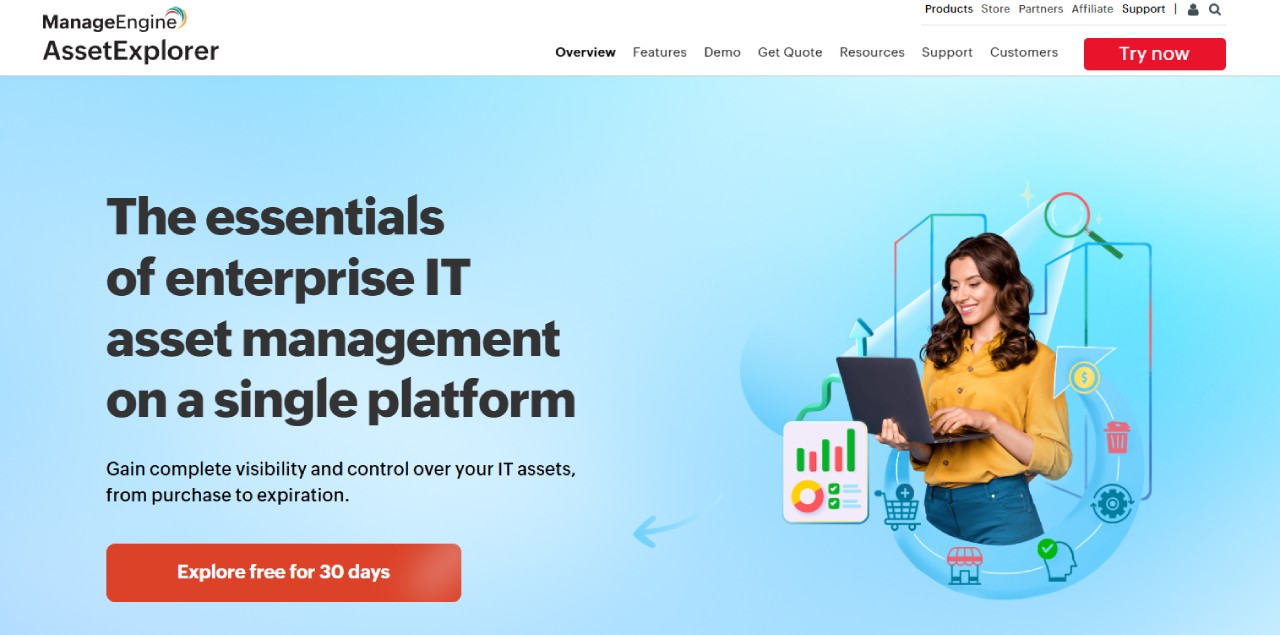
According to its official product page, ManageEngine® AssetExplorer is a web-based IT Asset Management solution designed to help organizations track and manage assets across their entire lifecycle, from initial planning and acquisition to retirement and disposal.
ManageEngine’s documentation also states that AssetExplorer supports both on-premises deployments and SaaS-based implementations, allowing organizations to choose the model that best aligns with their infrastructure, security requirements, and operational preferences.
ManageEngine AssetExplorer features
Based on the official AssetExplorer factsheet, the platform includes a range of capabilities aimed at improving asset visibility and simplifying lifecycle management, such as:
- Automated asset discovery - Detects hardware assets using multiple discovery techniques to maintain an up-to-date inventory.
- Visual Lifecycle Management - Provides drag-and-drop tools to define and manage asset lifecycle stages in a visual, easy-to-configure way.
- No-code automation - Enables teams to automate routine tasks like asset assignment and updates without scripting or development effort.
- Integrated CMDB - Centralizes configuration item data in a unified CMDB to improve accuracy and relationship visibility.
- Reporting and dashboards - Offers dynamic reports and visual dashboards with charts to support real-time monitoring and analysis.
ManageEngine AssetExplorer reviews
As of December 2025, ManageEngine AssetExplorer shows the following ratings on major review platforms:
- Gartner Peer Insights: 4.0 out of 5 stars (only 4 reviews).
- G2: 4.3 out of 5 stars.
- Capterra: 4.6 out of 5 stars.
ManageEngine AssetExplorer pricing
According to ManageEngine’s pricing information, AssetExplorer is available in three editions:
- Free Edition – Includes full functionality for environments with up to 25 assets.
- Trial Edition – A 30-day trial supporting up to 250 assets.
- Professional Edition – A paid edition offering complete functionality with licensing that scales based on asset volume.
Pricing varies depending on the deployment model and the number of managed assets. As of December 2025, published pricing examples include:
- Cloud deployment – From $115 per month ($1,245 per year) for 250 assets, up to $1,545 per month ($16,695 per year) for 10,000 assets.
- On-premises deployment – From $955 per year for 250 assets, up to $11,995 per year for 10,000 assets.
#4. Freshservice
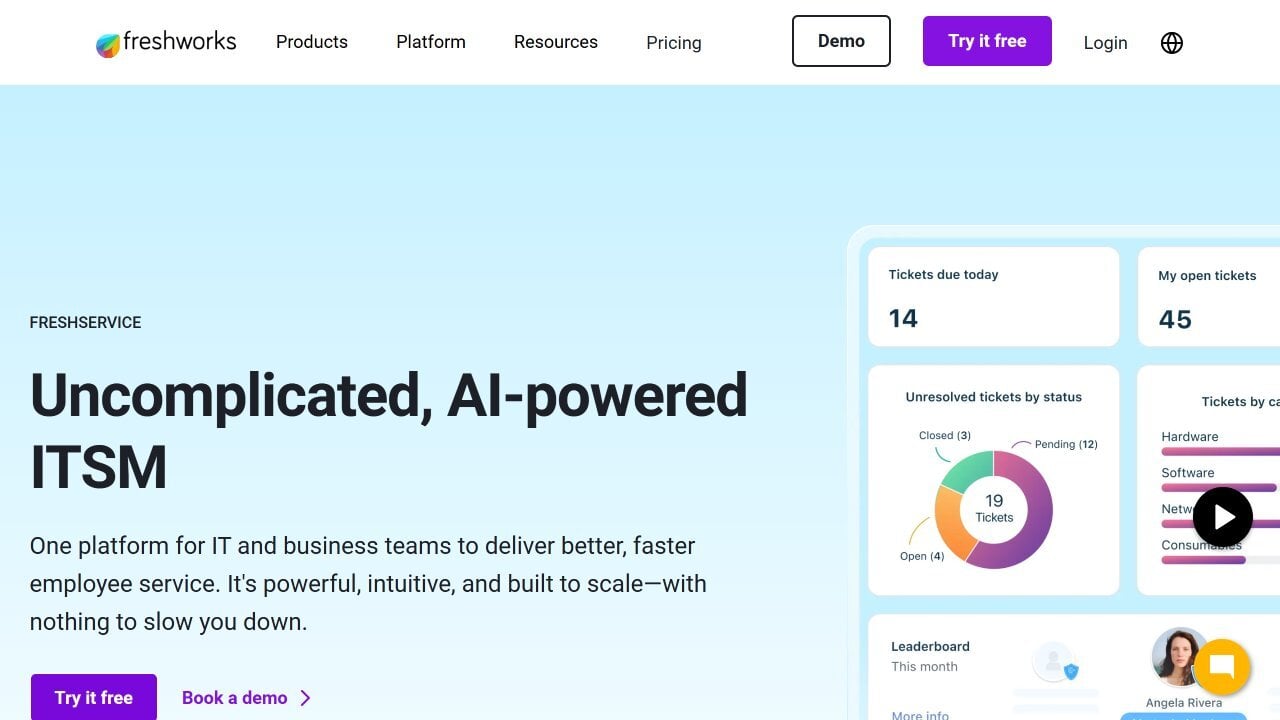
According to its official datasheet, Freshservice® is a cloud-based IT Service Management platform that brings together ITSM, IT Asset Management, and IT Operations on a single, unified system. It is designed to simplify IT environments by reducing tool sprawl while improving visibility, productivity, and service delivery.
Within this unified approach, Freshservice includes IT asset and hardware inventory capabilities that allow organizations to track physical devices alongside service requests and operational workflows, helping IT teams manage assets in context rather than in isolation.
Freshservice’s IT Asset Management capabilities are being expanded through Freshworks’ acquisition of Device42, with plans to strengthen discovery, infrastructure visibility, and dependency mapping capabilities.
Freshservice features
Based on information from the official Freshservice documentation and datasheet, the platform offers several capabilities relevant to IT hardware inventory and asset tracking:
- Unified IT asset inventory - Centralizes hardware assets within the same platform used for IT Service Management, reducing fragmentation and improving data consistency.
- Asset lifecycle tracking - Supports tracking hardware assets from acquisition to retirement, helping teams manage ownership, status, and lifecycle stages.
- Native ITSM integration - Links hardware assets to incidents, service requests, and changes, providing operational context and improving issue resolution.
- Automation and AI-assisted workflows - Uses built-in automation and AI features to streamline asset-related processes and reduce manual effort across IT operations.
- Reporting and insights - Provides dashboards and reports that help teams monitor asset usage, service performance, and operational efficiency from a single interface.
Freshservice reviews and recognition
As of December 2025, Lansweeper shows consistent user feedback across major review platforms:
- Gartner Peer Insights: 4.3 out of 5 stars.
- G2: 4.6 out of 5 stars.
- Capterra: 4.5 out of 5 stars.
Freshservice pricing
Freshservice follows a subscription-based SaaS pricing model structured around per-agent plans, typically billed annually but sometimes available with monthly billing options. A free 14-day trial is also available so organizations can evaluate the platform before committing.
According to Freshservice’s official pricing page, the standard pricing tiers include:
- Starter – Begins at about $19 per agent per month (billed annually), suitable for small teams starting with IT service and basic management functions.
- Growth – Starts around $49 per agent per month (billed annually), adding expanded functionality suitable for teams needing broader service and Asset Management.
- Pro – Typically $99 per agent per month (billed annually), designed for larger environments with more advanced workflows and controls.
- Enterprise – Customized pricing tailored to larger organizations with the most advanced needs; pricing is available on request.
All plans can be tried via a 14-day free trial before purchase.
#5. Ivanti Neurons for ITAM
 According to its official datasheet, Ivanti Neurons for ITAM is an IT Asset Management solution designed to manage both hardware and software assets across their entire lifecycle, from acquisition through disposal.
According to its official datasheet, Ivanti Neurons for ITAM is an IT Asset Management solution designed to manage both hardware and software assets across their entire lifecycle, from acquisition through disposal.
The platform centralizes key asset data such as ownership, lifecycle stage, location, and warranty details, and integrates with Ivanti Neurons for Discovery, Ivanti Endpoint Manager, and Ivanti Neurons for ITSM to provide broader visibility and operational control.
Ivanti Neurons for ITAM is available as both a cloud-hosted and on-premises solution, and includes mobile capabilities that allow teams to update and manage assets while on the move.
Ivanti Neurons for ITAM features
Based on information from Ivanti’s official datasheet, the platform offers several capabilities relevant to IT hardware inventory and Asset Management:
- Centralized asset repository – Maintains consistent and structured asset data from request and purchase through deployment and retirement.
- Integration with discovery tools – Ingests asset data from Ivanti Neurons for Discovery, Ivanti Endpoint Manager, and other sources to improve accuracy and reduce manual entry.
- Financial and contract tracking – Associates assets with purchase orders, invoices, and contracts to support cost control, compliance, and audits.
- Mobile Management and barcode scanning – Allows asset lookup and updates from mobile devices, including barcode scanning for faster identification and processing.
- Service Management integration – Integrates with Ivanti Neurons for ITSM to enhance incident, change, and service request workflows using shared asset information.
Ivanti Neurons for ITAM reviews
As of December 2025, aggregated ratings across major software review platforms show:
- Gartner Peer Insights: 4.3 out of 5 stars.
- G2: 4.3 out of 5 stars.
- Capterra: not enough information available.
Ivanti Neurons for ITAM pricing
Ivanti does not publicly disclose detailed pricing for Ivanti Neurons for ITAM. According to its plans page, IT Asset Management capabilities are included across its Service Management plans:
- ITSM Professional.
- ITSM Enterprise.
- ITSM Premium.
- ITSM Enterprise Premium.
For specific pricing details, Ivanti requires organizations to contact its sales team directly.
#6. Snipe-IT
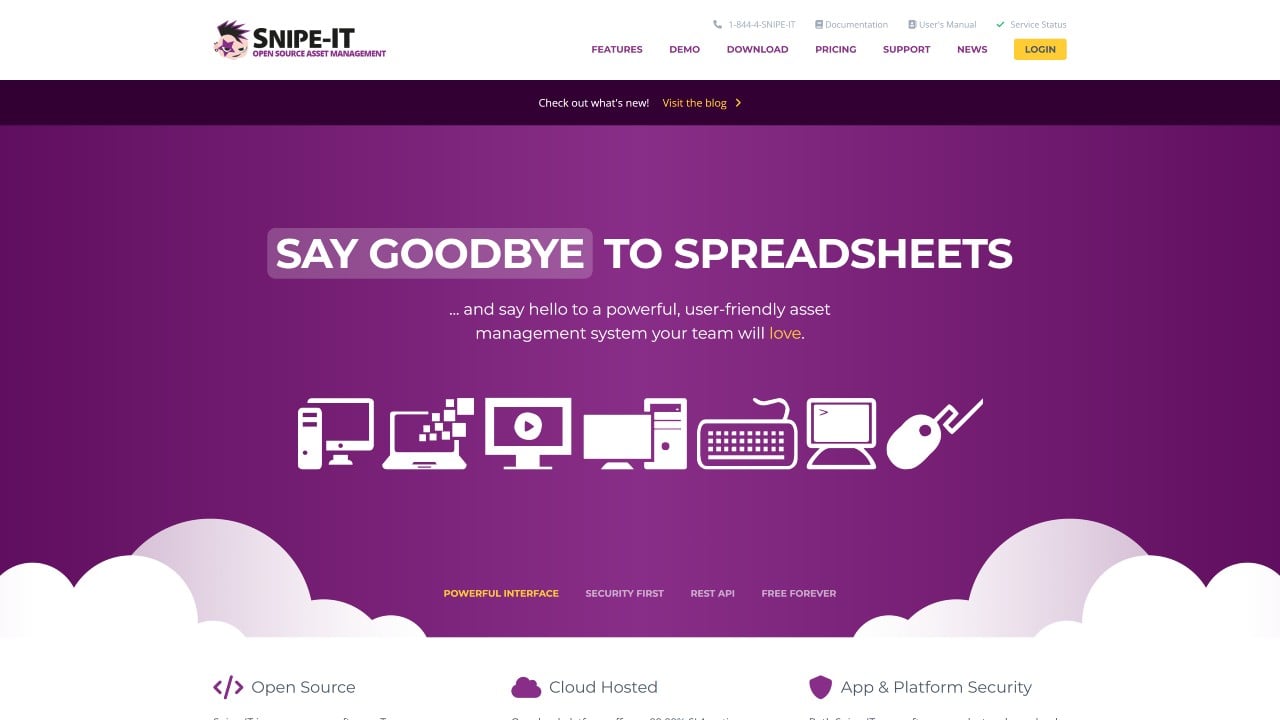
According to its official documentation, Snipe-IT is a free, open-source IT Asset Management solution designed to help organizations track hardware, software licenses, accessories, and asset assignments. It allows IT teams to see who is using each device, when it was acquired, and its current status within the organization.
Snipe-IT is a web-based system that runs on a server and can be accessed through any modern browser. It supports deployments on Linux, macOS, and Windows, giving IT teams flexibility to host the platform in a variety of environments.
Snipe-IT features
Based on information from its official product page, Snipe-IT includes several capabilities that support IT hardware inventory and asset tracking:
- Unified asset tracking – Shows which assets are in use, who they are assigned to, and their current condition or deployment status.
- Auditing tools – Enables fast inventory checks to keep asset records accurate and up to date.
- Barcode and QR code support – Works with common scanners and mobile apps to simplify physical asset identification and tracking.
- Custom fields – Allows teams to add organization-specific fields to capture additional hardware or software details.
- Lifecycle history logs – Records checkouts, returns, and maintenance actions to provide a complete activity history for each asset.
Snipe-IT reviews
As of December 2025, Snipe-IT has limited coverage on some review platforms:
- Gartner Peer Insights: No information available.
- G2: No information available.
- Capterra: 4.4 out of 5, based on 22 verified user reviews.
Snipe-IT pricing
According to Snipe-IT’s official pricing information (accessed December 2025), the platform is available in both self-hosted and hosted formats.
The self-hosted version is completely free, supports unlimited users and assets, and requires organizations to manage their own infrastructure and maintenance.
For managed hosting, Snipe-IT offers three paid plans:
- Basic Hosting – $39.99 per month or $399.99 per year.
- Small Business Hosting – $99.99 per month or $999.99 per year.
- Dedicated Hosting – $249.99 per month or $2,499.99 per year.
Hosted plans include automated backups, regular updates, SSL encryption, and enhanced technical support.
#7. AssetTiger
 According to its official FAQ section, AssetTiger is a cloud-based Asset Management platform developed by the team behind MyAssetTag.com. It is designed to give organizations visibility and control over their equipment, tools, and property through asset tracking, reporting, and audit capabilities (including IT hardware in simpler environments).
According to its official FAQ section, AssetTiger is a cloud-based Asset Management platform developed by the team behind MyAssetTag.com. It is designed to give organizations visibility and control over their equipment, tools, and property through asset tracking, reporting, and audit capabilities (including IT hardware in simpler environments).
The platform is fully web-based and does not require local installation. It can be accessed from any device with an internet connection and also offers optional consumable inventory tracking as an add-on to its core Asset Management functionality.
AssetTiger features
Based on information from AssetTiger’s official features documentation, the platform includes several capabilities relevant to asset tracking and Inventory Management:
- Multi-user access – Supports team collaboration through configurable user permissions. The free plan includes multi-user access, while paid plans allow unlimited users.
- Custom reporting – Provides both predefined and customizable reports covering asset status, depreciation, maintenance activities, and usage history.
- Cloud-based deployment – Operates entirely online without the need for installations or server maintenance, ensuring automatic updates and easy access from any browser.
- Email alerts and notifications – Sends configurable alerts for maintenance schedules, overdue assets, and contract or renewal dates.
- Barcode scanning – Enables audits and asset updates directly from the mobile app by scanning barcodes in the field.
AssetTiger reviews
As of December 2025, aggregated ratings across major review platforms show:
- Gartner Peer Insights: Not enough data available.
- G2: 4.5 out of 5 stars.
- Capterra: 4.6 out of 5 stars.
AssetTiger pricing
According to AssetTiger’s official pricing information (accessed December 2025), the platform offers a free plan that supports up to 250 assets, with limited access to core features.
Paid plans increase asset limits and unlock additional functionality:
- Basic – $20 per month for up to 500 assets.
- Core – $40 per month for up to 2,500 assets.
- Advanced – $75 per month for up to 10,000 assets.
- Pro – $140 per month for up to 50,000 assets.
- Enterprise – $275 per month for up to 250,000 assets.
In addition, AssetTiger offers a separate Inventory Plan for consumable tracking, available as a free version (up to 2 items) or an unlimited plan priced at $15 per month.
#8. Flexera IT Asset Management
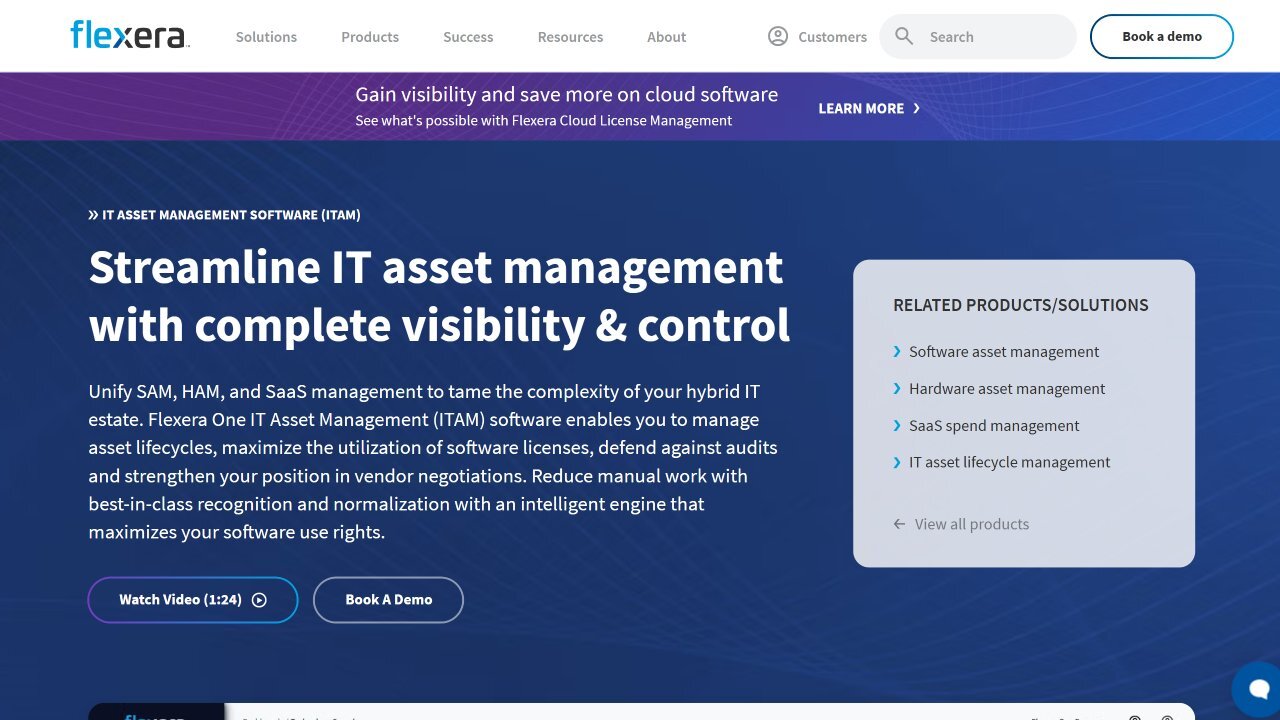 According to its official description, Flexera One IT Asset Management is an enterprise ITAM solution that brings together hardware, software, and SaaS management to simplify hybrid IT environments.
According to its official description, Flexera One IT Asset Management is an enterprise ITAM solution that brings together hardware, software, and SaaS management to simplify hybrid IT environments.
The platform is designed to help organizations manage asset lifecycles, optimize license usage, reduce audit risk, and strengthen vendor negotiations. It also reduces manual effort through intelligent recognition and data normalization capabilities that help maximize software usage rights across complex environments.
Flexera IT Asset Management features
Based on information from Flexera’s official datasheet, Flexera One IT Asset Management includes the following key capabilities:
- Asset discovery and inventory – Identifies applications, licenses, and assets using multiple discovery methods such as agents, browser extensions, APIs, CASB, and SSO across on-premises, cloud, and SaaS environments.
- Asset normalization and enrichment – Uses the AI-powered Technopedia catalog, curated and verified by domain experts, to normalize and enrich inventory data for higher accuracy and consistency.
- License compliance reporting – Aligns entitlements with deployed licenses to calculate the effective license position, with certifications and verification from vendors such as Oracle, SAP, and IBM.
- Application usage metering – Monitors how applications are used to optimize software spending, reduce compliance exposure, and identify shadow IT.
- ITSM and CMDB integrations – Provides certified integrations with platforms like ServiceNow and BMC, allowing ITAM data to flow directly into CMDBs and service management workflows.
Flexera IT Asset Management ratings
As of December 2025, aggregated ratings across major software review platforms show:
- Gartner Peer Insights: 4.6 out of 5 stars.
- G2: No distinct rating publicly available for this exact solution.
- Capterra: No distinct rating publicly available for this exact solution.
Flexera IT Asset Management pricing
According to information available on Gartner Peer Insights, Flexera One IT Asset Management follows a subscription-based pricing model. Pricing tiers are determined by the number of managed assets or devices and the set of enabled features, which may include hardware and software asset tracking, license optimization, and cloud management capabilities.
Flexera does not publish pricing publicly. Organizations interested in detailed pricing are required to contact Flexera’s sales team directly for a customized quote.
#9. ServiceNow IT Asset Management
 According to its official datasheet, ServiceNow® IT Asset Management is part of the ServiceNow AI Platform for business transformation. The solution applies an AI-driven approach to managing hardware, software, and SaaS assets across their entire lifecycle.
According to its official datasheet, ServiceNow® IT Asset Management is part of the ServiceNow AI Platform for business transformation. The solution applies an AI-driven approach to managing hardware, software, and SaaS assets across their entire lifecycle.
ServiceNow IT Asset Management is designed to help organizations reduce costs, mitigate operational and compliance risks, and improve overall visibility by breaking down data silos and automating asset lifecycle processes. Its goal is to eliminate redundancies, align technology investments with business objectives, and provide asset managers with centralized control over the organization’s technology portfolio.
ServiceNow IT Asset Management features
Based on information from the official ServiceNow ITAM datasheet, the platform centralizes and automates Asset Management processes through the Now Platform, combining AI, automation, and lifecycle optimization. Key capabilities include:
- Centralized asset visibility – Consolidates hardware, software, and SaaS asset data into a single platform, enabling full lifecycle oversight and consistent asset records.
- Lifecycle automation – Automates core IT asset processes from procurement to retirement, reducing manual effort and improving operational efficiency.
- Cost and risk optimization – Identifies redundant assets, reduces compliance and security exposure, and helps align technology spending with business goals.
- AI-powered Compliance Management – Uses AI agents to streamline publisher audits and support accurate license and usage compliance.
- CMDB integration – Connects IT Asset Management data with the CMDB to map dependencies and support impact analysis during changes and incidents.
ServiceNow IT Asset Management reviews
As of December 2025, ServiceNow IT Asset Management shows the following ratings across software review platforms:
- Gartner Peer Insights: not enough information available.
- G2: 4.4 out of 5 stars.
- Capterra: not enough information available.
- TrustRadius: 8.0 out of 10 stars.
ServiceNow IT Asset Management pricing
As of December 2025, ServiceNow does not publish standard pricing for its IT Asset Management solution. Pricing is determined through a custom quote process, based on factors such as organization size, selected modules, deployment scope, and required capabilities.
According to ServiceNow’s official information, pricing is evaluated individually through direct consultation and is designed to scale according to customer needs.
